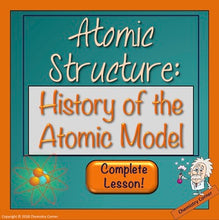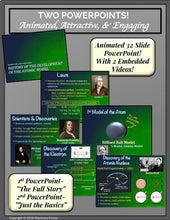The atomic model history—told as a timeline story. Two PowerPoints are included for you to choose from. The first is the full history of the atomic model from Democritus to the current Quantum Mechanical Model of the atom. The second PowerPoint is “Just the Basics” which includes the primary scientists, laws, and models.
Each PowerPoint has two embedded videos—short thought provoking videos that are sure to get discussion going.
This is a very interactive lesson that includes the student’s list of scientists, and two graphic organizers that are completed during the PowerPoint lesson. There are four pages of teacher notes that guide you step-by-step through the lesson with full description of what the students should be doing. This lesson can tend to be a bit dry and boring. However, with this interactive storytelling and students active involvement, my students love it.
Note: The PowerPoints included in this lesson are text editable, and slides can be added or deleted as you need.
In this lesson students are introduced to the history of the development of the atomic model. By the end of the lesson students will be able to:
♦ Identify the major scientists involved in the development of the atomic model, and site the scientist’s contribution.
♦ Identify the major experiments that lead to the current atomic model, and draw conclusions from those experiments.
♦ Identify the five major atomic models: Billiard Ball Model, Plum Pudding Model, Rutherford’s Model, Bohr’s Model, and the current Quantum Mechanical Model.
♦ Discuss the major laws and theories that led to our current understanding of the atomic model.
Prior Knowledge for Students: None
Teacher Prep Time: Just Print & Go!
Included in This Product:
✓ Two Animated PowerPoints—text editable
✓ Two embedded videos
✓ Two Graphic Organizers—“Laws & Theories” and “Atomic Models”
✓ Scientists Notes for students that follow the PowerPoint
✓ Complete Keys for the organizers and the scientists notes.
✓ Two different formats of the Quiz to choose from depending on the level of your students.
✓ Four pages of Teacher Notes with tips, background, and presentation directions slide-by-slide.
Lesson Duration: One to two 50 minutes classes-depending on discussion.
This lesson is appropriate for grades 9-12 chemistry or physical science, and possibly upper middle school.
Just Print and Go! Everything is ready for immediate use in your classroom. This will be a lesson you will want to use year after year!
Chemistry Corner
*************************************************************************************
Check out these other products that you may be interested in:
Atomic Structure: Ions and Isotopes
Atomic Structure: Protons, Neutrons, and Electrons
Atomic Structure: Average Atomic Mass
Atomic Structure Domino Puzzle
*************************************************************************************








